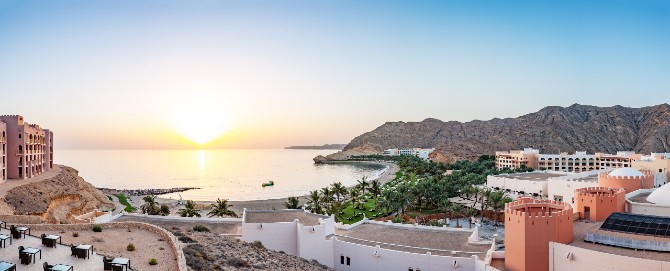Your essential guide to Muscat, Oman
27 November 2022
Strung between the Indian Ocean coastline and the Hajar Mountains, Muscat is Oman’s capital and largest city. It’s made up of several former villages, with three main regions: Old Muscat, where the Sultan holds court; Ruwi, a bustling residential and business district; and Mutrah, a historic quarter that’s a must-see for visitors.
The city is a heady mix of old and new, of cultural attractions and outdoor pursuits – all connected by a modern road network that offers easy access to the surrounding wadis (valleys), mountains and the Empty Quarter, the largest continuous sand desert in the world.
See

One of the most awe-inspiring wonders of Muscat – and indeed, all of Oman – is the stunning Sultan Qaboos Grand Mosque (above), the biggest mosque in the country. It can accommodate up to 20,000 worshippers and is built on a grand scale, with a gleaming white facade crowned with a 90-metre minaret and an ornate dome. There’s an Islamic centre on site where you can learn more about Omani traditions, try some local kahwa (coffee) and snack on dates while chatting with locals.
Do also check out the colourful Al Alam Palace in Old Muscat, the ceremonial residence of the reigning Sultan Qaboos. Built in 1972, its striking gold and blue exterior is a great example of modern Islamic architecture. Next to the palace, you’ll find Al Jalali Fort overlooking the bay. Built by the Portuguese in the 16th century, it was subsequently used as a prison before being converted to a private museum. While entry to the fort is limited to royal guests and heads of state, it’s still worth admiring its architecture from afar.
To learn more about Omani history and culture, the privately owned Bait Al Zubair Museum and the Oman National Museum are well worth a visit. The former features an extensive collection of ancient weapons, clothing, jewellery and household items, while the latter is home to 14 permanent galleries that each showcase a different aspect of Oman’s rich heritage.
Do

To see daily life in action, spend a morning exploring Mutrah Souq, a warren of narrow alleys lined with stalls selling Omani silver, frankincense, spices, textiles and so much more. Afterwards, stroll along the Mutrah Corniche (above) – a curved waterfront area with paved paths – to the Mutrah Fish Market, housed in a modern building whose sinuous form is inspired by Arabic calligraphy. Sip on fresh fruit juice from one of the many stalls and watch shoppers haggle over the day’s bounty.
In the evening, catch a show at the Royal Opera House Muscat, which has hosted some of the biggest names in music and ballet, including Italian tenor Andrea Bocelli and the American Ballet Theatre. If you’re unable to attend a performance, you can sign up for a guided tour of the venue to learn more about its distinctive Islamic and Italianate architecture, which pays homage to the style of modern Omani palaces.

Leave at least one day for side trips to the nearby city of Nizwa (above), with its large fort, mosque and bustling market; the enchanting Wadi Bani Kahlid, an oasis complete with green pools and palm trees; or the mountainous region of Jebel Akhdar, where damask roses and pomegranates are grown, and where you can glimpse Wadi Al Nakhr, dubbed the “Grand Canyon of Oman”.
Do also consider planning your trip around Muscat’s colourful events calendar. The Muscat Festival (January to February 2023) celebrates the best of Omani culture and heritage, with visitors getting the chance to enjoy traditional music and feast on delectable local dishes. Then there’s also the 11th Muscat International Film Festival (MIFF), which is scheduled for March 2023. The annual extravaganza will shine a spotlight on the best local and international films, spanning genres ranging from fiction to documentary and animation.
Eat

Oman has long been an important hub for trade and commerce. This is reflected in its cuisine, which is a delectable mix of Middle Eastern, Lebanese and Yemeni flavours, with a few distinctly local creations thrown in – think shuwa, a dish of slow-cooked lamb or goat, and majboos, a spiced rice dish typically served with chicken (above).
In the same vein, Muscat’s restaurant scene is delightfully vibrant and varied. Sample Omani food at the luxurious Al Angham, situated in the Royal Opera House Muscat, or at the more down-to-earth Bin Ateeq in Old Muscat, a 24/7 joint where you can tuck into fried camel meat while seated on the floor. You can also enjoy local delights at Candle Cafe on Shati Al Qurum Beach, where you can enjoy a falafel sandwich while gazing out across the sea.
Oman is home to a sizable Indian expatriate community (making up around 20% of the country’s total population), giving rise to some great restaurants. Book a table at Mumtaz-Mahal, a fine-dining venue that serves top-notch Indian cuisine with a side of panoramic city views. Alternatively, for traditional Turkish food in a beach setting, try Twins Turkish Cuisine – be sure to order the manti (meat dumplings) and grilled fish.
Stay

Fraser Suites Muscat (above) in the central business district offers guests a stylish home away from home. Take your pick from spacious one- to three-bedroom apartments, each featuring separate living, dining and bedroom areas. On-site amenities include a fully equipped gym, a rooftop pool, a luxurious spa with five treatment rooms, laundry services and a business centre; there are indoor and outdoor kids’ play areas for families too.
You’ll find a variety of retail stores, restaurants and even a shopping arcade right at your doorstep. If you’re venturing further afield, top attractions including Mutrah Souq, the Royal Opera House Muscat and Al Alam Palace are a short drive away. A shuttle service connects guests with several points across Muscat including the airport, which is a 20-minute drive from the property.

Not a Fraser World Member? Sign up today for free membership and enter a world of privileges
- Complimentary Stays
- Up to 20% off Best Flexible Rate
- Room Upgrade
- Early Check-in
- Exclusive Rewards
- Welcome Voucher

























